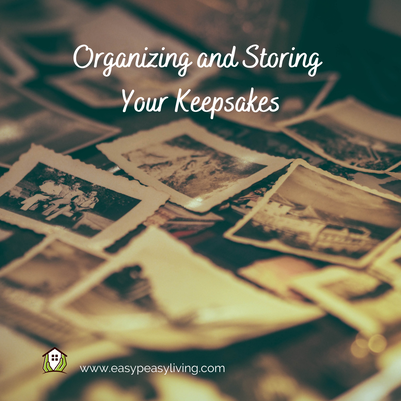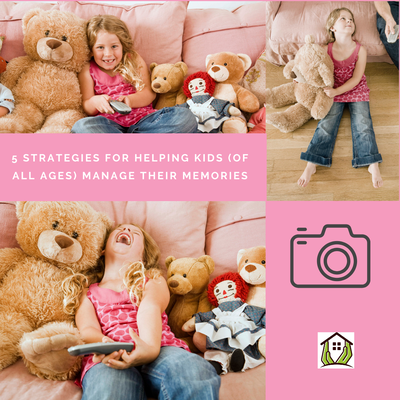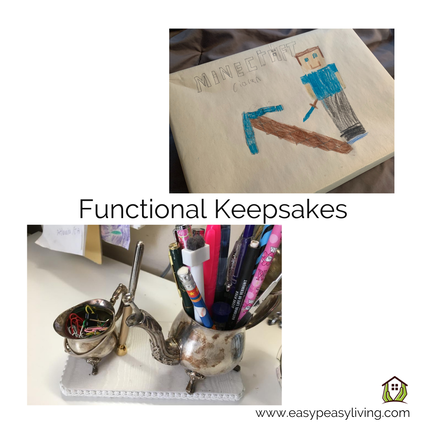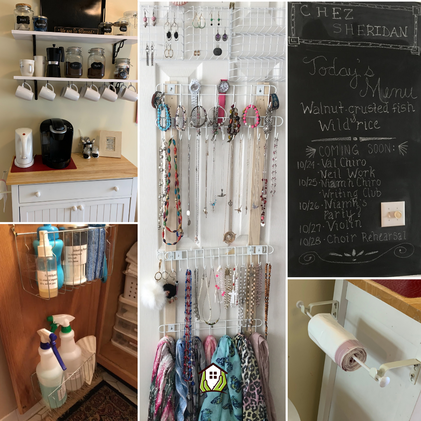 I love being a home organizer! Witnessing my clients’ sheer joy and relief at finally reclaiming their space always brings a smile to my face. Just the other day, I helped a client empty the storage unit she’d been renting for the past 18 months since moving from her home of 30+ years to a smaller condo…just in time to avoid paying next month’s rent!. (We celebrated with a chocolate milkshake…yum!) It’s amazing how much people actually love getting rid of stuff once they’ve made the decision to do it. So what makes deciding to do it so terribly difficult? Most often, not knowing what to do with excess belongings prevents folks from even starting to clear stuff out of their way. This procrastination leads to an ever-growing pile that eventually just feels too overwhelming for some. The longer they put it off, the more daunting the thought of shifting that enormous pile becomes. So it sits…and sits…and sits…gobbling up all of the available breathing space. That’s why I created a guide on how and where to donate, recycle or sell many of the most common items people struggle to divest. It has become the most-visited page on my website and elicits a surprising number of emails from readers wanting to contribute their own suggestions on what to do with all manner of cast-offs. If you haven’t yet visited this treasure trove of information, you’ll find it here in the Free Resources section. I encourage everyone to become part of this collaborative effort and email me if you know of ways to donate, sell, recycle or repurpose in ways not already mentioned. If you’ve been following my blog or Facebook page for any length of time, you’ve no doubt heard me mention the Buy Nothing Project. For those who are unaware of this enterprise, I strongly recommend visiting their website to learn more and consider joining your local group, especially if you yourself have excess stuff you need out of your way but don’t know how to go about getting rid of it. It's all about neighbors helping neighbors...and who doesn't love that?!! Many items that can’t be donated to charity can be shared with your neighbors who need them through a Buy Nothing group. Some examples include food items; opened-but-no-longer-wanted self-care items like shampoo/conditioner, nail polish, lotions or first aid supplies; leftover construction, DIY or craft materials; clothing or other household items with slight defects; cleaning solutions; broken electronics (yes, someone handy may want to fix them or use the parts); empty boxes, jars and packing materials. Heck, one woman in my group was even collecting leftover vegetable peels for making natural dyes! Many of my clients find it easier to part with their more sentimental objects when gifting them to someone that they know really needs or wants them than by merely adding them to a donation box without knowing exactly where they will end up. All it really involves is posting a photo and brief description on the group’s Facebook page to be connected to members who are interested in what you have to offer. If you want to give Buy Nothing a try but aren't sure where to start, request a copy of my free guide to joining and using Buy Nothing. Once you join your local group and understand how it works, getting rid of unwanted items as you go becomes easy peasy and prevents unwanted pileup in your cabinets and closets. It's truly a win for everyone, including the environment! Nothing feels better than coming together as a community to meet each other’s needs. My need for more space and your need for the items I no longer want that are hogging all of it are a match made in heaven! With a little information on what to do with all that stuff, even reclaiming your space can be easy peasy!
0 Comments
 The start of another school year is upon us! No doubt you’ve stocked up on pencils and a rainbow of pocket folders. The kids have brand-new sneakers or a snazzy new lunchbox or backpack. You’ve filled out the endless forms and read notes from your child’s teacher/s. Those of you sending them back in person after 18 months of home schooling may even have some champagne on ice for toasting your triumphant return to some well-earned peace and quiet at home during the weekdays. But the preparations don’t stop there. I’ve polled teachers at all levels (preschool, elementary, middle and high school) to find out what, beyond the obvious stuff of buying supplies and communicating with the school, parents can do to ensure a successful school year. Even after 13+ years at this school-age parenting thing, I learned a few things I could be doing better. Here’s what they said: For younger kids (preschool through elementary)
For older kids (middle and high school)
For kids just learning English
For all age groups
And now, the #1 response from all teachers at all levels…(drum roll, please)
And speaking of reading, you’ve already taken the first step in helping your child have a successful school year just by reading this blog post! Stay tuned for more Back to School tips over the next few weeks. Here’s to a fantastic 2021-22 school year! [champagne bottle pops]  How many boxes and bins of stuff are you storing for purely sentimental reasons? How cluttered are your shelves and cabinets with stuff you’re reluctant to part with because of all the memories they evoke? Whatever your answer, you’re not alone. Keepsakes...memorabilia...souvenirs...whatever you want to call them, are often the most troublesome belongings to maintain control over for everyone, myself included...and I can be downright ruthless when it comes to getting rid of stuff I don’t use regularly. As we struggle to figure out where to start in establishing order over it, more trinkets continue to pile up, making the task at hand ever more daunting. Organizing your keepsakes is no different from any other organizing project. We begin with three primary goals in mind:
Let’s take a closer look. Reducing Volume First, decide how much space you’re willing to devote to your sentimental objects. Remember that stuffing them into a storage bin in the back of a closet or the deep recesses of your garage won’t allow them to trigger the memories...and that’s the whole point of keeping them, right? With that in the front of your mind, try some of these strategies to reduce the amount of space they gobble up:
Creating Easy Access Let’s be honest...how likely are you to dig out those big rubber storage bins and old cardboard boxes from the crawl space in your attic and spend hours pouring over your kids’ old artwork? Yeah...that’s what I thought. So why are you keeping it? While most people neither plan to nor need/want to devote time to regularly reviewing their scrapbooks and photo albums, those options offer the ability to more easily find and share precious memories as long as they are stored within easy reach. The less you keep, the easier it is to create easy access to your memories so that you can pull them out when the mood or opportunity to share them strikes. And you don’t have to be a crafty scrapbooker to do it. The key is to reduce the volume enough that you can store them in an easy-to-reach section of your living space rather than in the basement, attic or garage. Imagine Cousin Sue comes over for lunch and you get to reminiscing. How easy will it be for you to pull out that stack of old letters she sent you from summer camp when you were kids? Make it so. Consider some of the storage methods below and select the ones that work best for you and your family:
Preserving and Identifying Most people keep some combination of memorabilia they’d like to pass along after they are gone and items that carry meaning for no one else but them. Do your loved ones a favor and differentiate between these two categories to make their job easier when faced with the daunting and emotional task of going through your things after you pass. I know it may sound morbid, but knowing you have done your part to make that process a little bit easier for them will ease some anxiety for you now, while also ensuring that you will be leaving them precious memories instead of just more stress to add to their grief. Here are a few loving steps you can take to achieve this:
Of all the items you make space for in your home, your keepsakes are really the only ones that can’t be replaced. If they are worth keeping, they are worth devoting some time and effort to preserving with care. While it can be overwhelming to think about that huge stash of old papers, photos and trinkets stashed away in your attic (or wherever), tackling it now and making some intentional decisions to transform it into a more manageable storybook of your life will be some of the most enjoyable and thought-provoking work you’ve ever done. With these three stated goals and the creative, yet practical strategies I’ve laid out over the last few blog posts, even establishing order to your keepsakes can be easy peasy.  Raise your hand if you either have kids or were once a kid yourself. If you raised your hand, this one’s for you. Kids and former kids alike tend to struggle with letting go of items that represent memories. Even I, the queen of getting rid of stuff, struggle from time to time. No matter how much of a minimalist you may be, guaranteed you’re hanging onto some things merely because they remind you of special memories, people, or achievements. And there’s nothing wrong with that just as long as you’re doing it selectively and with intention. But so often, we end up holding on simply because we aren't sure how, when or whether to let go. That keeping-by-default approach eventually leads to clutter, which in turn leads to disorganization when the clutter becomes unmanageable. Learning how to make choices about your belongings with confidence is key to avoiding what I call "clutter creep”. Teaching kids that skill is as important as teaching them to balance a checkbook, yet it’s one aspect of child-rearing that often gets overlooked because parents themselves never learned how to do it. Kids are notorious for wanting to keep everything under the sun because they haven't yet fully experienced the many negative consequences of clutter creep. And if no one teaches them how to make thoughtful, intentional decisions about their stuff, they’ll continue to keep by default and grow up to be former kids who feel compelled to keep everything. Perhaps you know someone who fits this description? The good news is that by learning just a few simple strategies, they can instead grow up to enjoy a lifetime of clutter-free living as adults and save you from grappling with their clutter creep in the meantime (perhaps on top of your own). So whether you’re hoping to raise a de-cluttered kid or to become a de-cluttered former kid, read on. First, two important points to remember when it comes to keeping memorabilia: 1) Their main function is to trigger a positive memory (thus the name “memorabilia”) 2) Less really is more. Think about this for a minute: How is a huge stash of photos, old school papers, certificates, artwork, old birthday cards and so on helpful in preserving memories from the past? Not only is it in your way, limiting activity in your present and threatening productivity in your future, but all the memories that stuff represents are currently hidden in a big, anxiety- and stress-provoking mess. In order to trigger any precious memories, you would have to take time to sit down and actually go through that big pile, piece by piece...yet most of us are actively avoiding the big pile... which is precisely how it has grown so unwieldy. We’re procrastinating looking through it because it's overwhelming. It represents unmade decisions, uncertain outcomes and sometimes even guilt as the pile continues to grow. It doesn’t feel fun or inviting the way your old memories should feel. Add to that the visual noise and inconvenience of having to live around it. Whether you’ve stashed it all away in some storage closet or are tripping over it every day, it is there...unmanageable and unconquered...nagging at you in the back of your mind (or maybe even in the front of it). At some point, that huge stash of what is supposed to be positive memories has become a big pile of negativity. And guess what...your kid's stash can feel that way to them too. So what to do with it? Strategy #1: The Transformation Challenge A couple of weeks ago, I talked about functional keepsakes in this blog. If you missed it, go back and read about them here. The idea is to transform your 3-dimensional keepsakes into something that serves a practical purpose. An example would be a big seashell your child collected during a family beach vacation. Help her brainstorm ways this purely sentimental object can fulfill a functional need. Turn the shell upside down and voila! it becomes a dish for holding small items such as change, paper clips, tiny earrings, etc. The point is to clear some space by replacing an everyday, mundane, purely functional object with something that is both functional and memory-evoking at the same time. In this example, by transforming the shell into a change-holder, you can ditch the boring plastic container that was previously holding change. Thus, you are eliminating clutter without eliminating the memory. Plus, every time your child places change in the shell, it will evoke positive memories about his beach vacation. Win-Win! Challenge your kids to see what ideas they can come up with. You'll be amazed at their creativity, and they'll feel so proud of their own cleverness. Strategy #2: The Keepsake Box Last week’s post focused on how to keep paper keepsakes under control. Most kids don’t understand the concept of “less is more”, but keeping every school project, essay, drawing, handmade card, and certificate they ever received is not going to be valuable to either of you down the road. Help them to see what they are losing by keeping more. Would they rather look through the big, scary pile of papers on their desk to find and admire their old artwork, or use their desk for drawing something new? Would they rather spend the afternoon looking through a pile of old birthday cards from their best friend, or playing outside with that friend? Instead of keeping everything, limit the paper keepsakes to just what will fit inside a defined and manageable space such as a keepsake box and encourage them to choose with intention what goes in it. When the space gets full, it's time for your child to sit down, review everything in the box (and evoke some cool memories) and then eliminate items that are no longer as meaningful as they once were in order to make room for new ones. This weeding out process gives them an opportunity to practice making intentional decisions about what to save while keeping them in charge of their own stuff. Consider using a box that they themselves have decorated or another vessel that conveys special meaning, making the receptacle itself a functional keepsake like the objects described in Strategy #1. Defining the space ahead of time keeps the pile manageable. Decide together in advance the rules for when it’s okay to add a second box (every five years? every ten?) and stick to those rules. This will depend on how much space you are both willing to devote to paper keepsakes. Remember, the less stuff you keep, the more space you have available for enjoying life and creating new memories!! Strategy #3: The Art Gallery Artwork often represents a unique challenge for parents, especially if your child is a prolific artist. Once again, less is more. You can save space in your keepsake box by displaying any drawings and paintings instead. Borrowing the concept of limited storage space from strategy #2, create a gallery space specifically for this purpose using a bulletin board, the refrigerator, frames in a hallway/bedroom, or pages of a portfolio...whatever works best for your family. (I'll share more ideas for keepsake organization in next week's blog post.) Define the space ahead of time and don't exceed it. Have your child decide what gets displayed and for how long. When a new masterpiece comes along, leave it up to her to decide what needs to go in order to make room for it. This not only allows him to practice that crucial decision-making process again, it also alleviates any guilt you might feel about tossing your little Picasso's creations. Strategy #4: The "Vacation" Rotation So what about trinkets and toys that cannot be transformed into functional objects and won't easily fit in a keepsake box, scrap book or on a gallery wall? Ever notice how kids develop a sudden strong attachment to toys they have long outgrown and forgotten all about when they discover them in the “Donations” box? When saying goodbye forever is too much of a struggle, teach your kids to say "bon voyage" instead, and place these items into temporary storage for 3-6 months. Make note of their scheduled return date. If your child hasn't mentioned them or asked for them by that date, extend the "vacation" a bit longer. If they still don't ask for them, this is a sign that they may be more ready to part with them than they thought. If they still insist on keeping them, negotiate a swap for some other toys they no longer use. Again, this allows them to practice making choices and keeps them in charge. While it’s tempting to discard items you’re sure they won’t miss while they are napping or at school, this can lead them to cling even more fiercely to sentimental objects and potentially introduce a level of distrust into the relationship that you don’t want. Even more importantly, you’ll miss precious opportunities to help them practice letting go of their own accord. Strategy #5: The Photo Shoot/Book Tour Sometimes saving the actual object is not required to trigger a memory. They say a picture paints a thousand words, so a photo or even a short story about an object may be a more practical and appropriate solution. Make it fun and creative! Set the mood with a fan and some mood music while you play pretend professional photographer and conduct a photo shoot of your child with all his to-be-donated stuffed animals, dolls, or dinosaurs. Invite friends or siblings to join in. Or encourage your child to write the story of an object...where it came from, why it's special, what adventures they hope/imagine it experiences in its next "life" after donation. Allow him/her to share the story with family and friends a la book tour. Documenting the important role this object has played while it is still fresh in their minds will preserve the memory in more intricate detail than saving the thing itself ever could. They are putting into words or capturing in photos what the object means to them right now rather than having to rely on a vague recollection of it down the road. Parting with stuff--for adults and kids alike--feels bad because we fear forever losing the memories it triggers. No wonder we avoid it! But having adequate space to live in and create new memories...feeling organized and in charge of our own environment...that feels really good. Teaching your kids these strategies and giving them opportunities to practice making intentional choices will empower them. With a little patience and a few good strategies, even raising de-cluttered kids (or becoming a de-cluttered former kid) can be easy peasy.  Save space by transforming your sentimental objects into functional ones. Save space by transforming your sentimental objects into functional ones. No matter how much of a minimalist you are, you likely have a few treasured keepsakes stashed away somewhere in the hard-to-reach spaces of your home, if not consuming valuable real estate in your closets, cabinets and drawers. I’m willing to bet these trinkets represent a little bit of a challenge to your sense of organization, too. Organizing is all about managing your stuff with efficiency, so you probably already know that the first step in any organizing project is to purge excess items you don’t really need or use. For many of us, this leads to a dilemma: how do we justify storing boxes and bins of old memories whose only purpose is to give us the warm fuzzies? The mere thought of parting with beloved memorabilia evokes feelings of guilt or sadness, yet keeping them feels self-indulgent and counter-productive. Well, I’m here to assure you that you need not sacrifice your favorite childhood mementos in the name of organization. The key is in discovering a dual functionality for some, and assuming the role of a highly selective curator for the rest. First, it’s important to recognize that less really is more when it comes to memories. Think about why items in a museum are so valuable. It’s because they are representative and rare. Second, understand that you cannot experience the nostalgia these items evoke unless you actually see them. If you pack them away in a storage bin in the attic or shove them in the back of your closet, they can’t fulfill their function of sweeping you down memory lane unless you drag them out and look through them. The more you have, the less likely you will be to do that. Seriously, when was the last time you made the effort to do that? The challenge is to save just enough to preserve your cherished memories without creating unnecessary clutter or robbing yourself of the space you need for other items. One way to do this is to bring them out into the sunshine of your everyday existence and assign them a second function that enables you to eliminate other, less meaningful objects. Here are a few examples of what I mean:
Follow EasyPeasyLiving’s “Organizing Outside the Box” board on Pinterest for more ideas on ways to repurpose objects in a functional, yet meaningful way. The possibilities are truly endless and limited only by your creativity. Now obviously not every keepsake can be transformed into a functional object, and the idea of tucking away a few meaningful pieces in “time capsule” fashion has an appeal all its own. Just keep in mind that the best time capsules are a) representative and b) small. In other words, be selective about what you save, and define the space you are devoting to keepsake storage first. If you start to outgrow the space, review the contents and eliminate objects that are no longer as relevant as maybe they once were. If you can’t remember the significance of a piece, let it go. A special note to parents: Involve your children in the decision-making process whenever possible. Let them select the artwork that means the most to them while teaching them how to make balanced, selective decisions. Do not fall into the trap of saving too many old toys, school papers, or baby clothes they’re not likely to remember. They will not thank you for offloading boxes of, what to them, is a bunch of meaningless old junk when they move out or you pass on. With a little creativity, even preserving your memories without sacrificing space can be easy peasy! Do you know someone who could use help taking back control of their home, life and schedule? Encourage them to subscribe to the EPL Blog by sharing this link with them.
 As we wrap up Organizing for Dollars month, I want to share with you the many ways paring down your belongings can actually save you money. After all, who doesn’t want more of that? The less you own, the easier it is to keep your home tidy, organized, and accessible, meaning:
If you take some of the advice I’ve shared this past month on using items you already have on hand to fulfill a need or creating your own inexpensive organizing solution, you’ll save even more money. Making wise purchases that serve as multi-taskers means buying and storing less. Add all of that to the time you’ll save from having less to manage and navigate around at home, and you can see that less really is more...more time, more space, more peace of mind and yes, more MONEY! And if that’s not enough, you now have a chance to score a $15 gift card just by visiting my Facebook page and commenting on the 1-Day Challenge post at the top telling us something you had been planning to buy and what you ended up using that you already had instead. Everyone who answers both parts of the question in a comment by July 31 will be automatically entered into the prize drawing. Easy Peasy! Stay tuned next week, because August is Keepsake Organization month. I’ll be sharing tips on how to add functionality to your sentimental objects, curate your keepsake collection to tell your story, preserve memories without having to keep a pile of stuff that triggers them, and organize the precious items you save.  Living life seems to require a lot of stuff. We need stuff to wear...stuff to cook and cook with...stuff to sit, sleep, eat, and work on...stuff to entertain us and stuff to help us entertain others...stuff to help us work more efficiently...stuff to read, write and communicate with...stuff to decorate and create with...stuff to keep us safe and healthy...stuff to make us more comfortable...stuff to keep us smelling, looking and feeling our best...stuff to help us relax...stuff to give each other and stuff to wrap it up in...stuff to keep us warm and stuff to keep us cool...stuff to fix and clean all our other stuff with...and stuff to keep all this stuff organized and accessible when we need it. And every single piece of stuff we own comes with a price tag...not just a financial price tag but also a time, space, effort, convenience and opportunity price tag. Reducing the amount of stuff you own also reduces your overhead costs. Minimalism is about getting by with less stuff so that you can focus more on all those other things that really matter in life. But you don't have to be a minimalist to benefit from making do with less. July is Organizing for Dollars Month, so today I’m going to share a few strategies for shrinking your pile of stuff to save you money...plus a whole lot more. One reason we get so overwhelmed by all of our stuff is that most of us own waaaaayyyyy more than we need or have room to accommodate. We go through phases where we get so fed up we decide to weed out our closets and donate our excess...and it feels pretty great for a while. But eventually, we end up right back where we started, because we never changed our thinking about what we really need versus what we just want. To change your mindset, you must begin challenging yourself to stop acquiring something new to fulfill every new need that arises. With a little resourcefulness and creativity, you can meet most of your needs by shopping in your own closet. If you don’t believe me, why not try imposing a moratorium on new purchases for one whole week and see for yourself how well some of these seven strategies can work: 1. Use up what you have first before replenishing How many skincare samples, hotel shampoo bottles, and still-in-good-shape gift bags are you hoarding? For what? Start using them. Get them out of your way before you buy more of the same. Plan meals around the food that’s been in the back of your pantry or freezer and needs to get eaten. (Read this great article on the myths of food expiration labels before you pitch it.) Use items in your craft supply stash or some of those leftover DIY materials in the garage to create something you need rather than pulling out your wallet to buy it. You’ll be amazed how much money and space you’ll save just by using up the various odd bits and pieces that are currently filling up your cabinets and drawers. 2. Review your stashed decorative items Are your closets and storage areas filled with framed photos or artwork you took down but may want to use again...someday? What about all those cute tchotchkes you’ve been saving in some bin somewhere because they have sentimental value but no good spot to call home? Review these with a critical eye and make some decisions. Perhaps some can be made into functional objects or to freshen up your current decor. Others may make wonderful gifts. If you’ve been meaning to hang it up, then do it now! You’ll free up valuable storage space and fulfill a need without spending a cent. 3. Gift/regift new items you know you’ll never use. Rather than spend valuable space on something you don’t need/want, give it to someone who would. You’ll save time and money on gift shopping, not to mention space! 4. Gift wrap creatively Instead of buying special occasion-specific wrapping paper, you’ll get more mileage out of it if you use neutral gift wrap suitable for any occasion and embellish it with items from your garden or leftover craft supplies. Reuse gift bags that are still in good condition or re-purpose all manner of materials as creative wrapping. An old sweater you’ll never wear plus a needle and thread and some ribbon are all you need to make a one-of-a-kind gift bag for Christmas. 5. Furnish your home with “double-duty” pieces Look for opportunities to double up on the functionality of your high ticket items, like furniture. Some examples are using a storage trunk or ottoman for a coffee table; turning a narrow cubby-style bookshelf on its side and adding a seat cushion to the top to create seating with book or toy storage; mounting a small ironing board to the top of a rolling storage cart. Look for end tables with drawers, console tables with shelves underneath, and desks with built-in filing drawers. 6. Rely on multi-taskers when entertaining Instead of overstocking your kitchen and dining room with specific serving pieces and party supplies, try some of these substitutions using what you already have on hand:
7. Give your kids experiences as gifts Let’s face it: raising kids is expensive, especially if you want them to experience life to its fullest. Instead of spending money on tangible gifts you’ll just need to find space for, use it to splurge on a fun trip or activity you may not otherwise be able to afford to celebrate a special occasion or holiday. One bonus is that these gifts are a lot easier to wrap too! Obviously, the more organized your home is, the easier it will be to fulfill a new need with an old purchase, because you’ll have a better handle on what you already own and know where to find it. And the less you own, the easier it is to keep everything organized and accessible. If you’re drowning in belongings, the first step is to turn off the tap and stop acquiring! Once you get used to looking for a solution in your own closet instead of a store, it will become a habit. In case you missed it, this month’s EasyPeasy 1-Day Challenge is to substitute something you already own for something you were planning to buy. To enter the monthly gift card drawing all you have to do is visit my Facebook page by July 31 and comment on the July 1-Day Challenge post at the top of the page telling us 1) What you were planning to buy and 2) What you found in your own home to fulfill the need instead. You must include both parts to be entered into the prize drawing. I can’t wait to see how clever and resourceful you all are!  Clockwise from upper left: coffee station, jewelry organizer, chalkboard wall, garbage bag/paper spool, cabinet door rack Clockwise from upper left: coffee station, jewelry organizer, chalkboard wall, garbage bag/paper spool, cabinet door rack Home stores are making a killing marketing tools and gadgets to help you save space and organize your cabinets, closets and drawers. The problem, aside from their pricetag, is that many of them turn out to be uni-taskers, that is they can only be used for a single purpose. When your needs change, many of these specialized items are no longer useful and merely clutter up your home...which is the very last thing you need when trying to restore some order. This week, I want to share with you just a few of my favorite DIY organizing tools that are not only helpful space-and-sanity-savers but also very easy and economical to make yourself. These are just a few examples. With a little creativity and resourcefulness, you can come up with more of your own just by looking through your pile of excess stuff with an inventive eye. I am listing the materials I used for each of the projects below and have estimated what it would cost if you had to purchase them all. However, it is my hope that you will be able to use whatever you already have on hand or acquire items for free from friends or neighbors who may have some to spare to reduce your costs...perhaps down to nothing. Substitutions are encouraged! Your local Nothing Project or Freecycle groups can be great resources for scoring free materials. (See the photos above for reference.) Jewelry Organizer Keep jewelry easily visible, accessible and tangle-free while saving boatloads of space in your bedroom with this simple DIY organizer you can hang on the inside of your closet door. Cost: Approximately $10 Materials:
Cabinet Door Rack Increase storage space in the kitchen and bathroom for as little as $1 with this quick and easy project. You’ll want one for every cabinet in your home. Cost: under $5 Materials needed:
Tip: Increase the versatility of these wire door racks by fitting them with small plastic cups or jars that can hold items that would otherwise slip through the wires. Garbage Bag/Paper Spool This clever trick keeps rolls of garbage bags, food wraps, paper towels, and wrapping paper at your fingertips and saves space in your overflowing cabinets! Cost: You can make several for about $7 total Materials needed:
Chalkboard Wall Keep everyone in your household on the same page with a fun chalkboard wall. Why limit yourself to one chalkboard when you can have an entire wall to write messages, share important info, and keep track of upcoming events, all in a central spot in your home. Cost: About $8 Materials Needed:
Coffee Station Set up a cute coffee station in your kitchen or dining room to save oodles of kitchen cabinet space and make it easy for guests to help themselves to hot beverages when you entertain. Cost: varies
These projects are just the tip of the iceberg. Unleash your creativity and see what you can create to suit your organizing needs using stuff you already own. Convert a storage trunk into a filing cabinet or a piano bench into a giant jewelry box. Make a scarf hanger by taping shower curtain rings onto a hanger. Send photos of your creations to [email protected] or tell us about them in the comments. Visiting Pinterest for ideas before ordering fancy organizers online can save you lots of money you can use on something way more fun than organizing your closets or pantry! Don’t miss next week’s blog, where I’ll tell you how to shop smart and get more bang for your buck out of the stuff you own so that you can own less stuff.  If you’ve ever been inside The Container Store or gone shopping for new food storage bins for your pantry, you know just how overwhelming -- and expensive! -- it can be to purchase the tools all those home magazines say you need to get organized. It’s enough to scare off even the best-intentioned from getting started. So my first piece of professional advice when it comes to shopping for baskets, bins and drawer dividers to create order in your home is...just don’t. At least, not yet. And maybe never. For starters, acquiring more stuff, no matter what it is, is probably the very last thing that will improve your situation. Most people already have way too much stuff, which is a primary factor leading to the current disorder in their homes. Purchasing more will only exacerbate the problem. Secondly, you can’t possibly know what to buy until you know how and where you will be using it. Guessing (and likely guessing wrong) will cost you time and money you may not have and lead to greater frustration. I’m assuming you already have plenty of that, am I right? Finally, your shopping excursion will feed into the false notion that it is a lack of organizing tools that has created the disorder in your home rather than the lack of an organizational plan. I’m sorry to tell you that there is no magical invention sold in the home goods section that will transform your chaos into calm without a solid understanding of how you use your space and a plan that reflects this. Now that we’ve dispensed with what you shouldn’t do, let’s turn our attention to what you should. Obviously, you’re going to need a place to put all your stuff once you’ve purged your excess and sorted it into tidy categories. The good news is that with a little resourcefulness and a smidgen of creativity, it doesn’t have to cost you a single red cent to organize your home. Start by raiding your recycling bin for jars, boxes (shoe boxes are great), plastic containers of varying sizes, and old shopping bags. Gather some ziploc bags, scissors, tape, a stapler, a few labels (or blank paper if you don’t have any) and a marker. You are now ready to begin purging your excess stuff, sorting what’s left into categories and designating homes for each category according to how you use it and how accessible it needs to be. Once you know where you want to store your items, select or create holding spots or dividers as needed to keep them neatly separated and labeled using the materials you’ve gathered. Need drawer dividers? Make some using strips of cardboard and some tape. No crock to hold all your large kitchen utensils? No problem. Just grab a large jar, flower pot, or an old pitcher. Lots of earrings but no jewelry box? Repurpose a box grater to hold the danglers and a small glass dish for your studs. You are limited only by your imagination. Yes, I hear you...you want a pantry worthy of Instagram, with matching jars labeled using trendy fonts. The good news is that if that’s your thing, you can still have it. The even better news is if that’s not your thing, or if you can’t afford that level of luxury, you can keep your homespun organizing solutions until you can...or forever. The functionality will still be there, and if the cardboard tears over time, there’s plenty more where that came from. Either way, you end up saving money by testing out your new organizing system without investing any money in pure aesthetics. If you plan to upgrade later, start making a wish list now of the organizing tools you want to purchase. Include specifics like what size, shape, material, color you want that will work in your space. If you used a transparent container to store something but are bothered by the visual noise, make a note to purchase an opaque version. If stacking your open bins would save more space in the cabinet, consider buying ones with lids. The longer you wait to go shopping, the more likely you’ll make wise choices to suit your needs once you do. Save big bucks and add a personal touch to your space by repurposing purely sentimental objects into functional ones. This is an excellent way to place the object in your path where it will trigger all those wonderful memories instead of consuming valuable storage space in the back of a closet where you will rarely encounter it. You’ll be amazed how easy it is to divide your spaces, create holders for items both large and small, establish zones, extend your storage, and make items more accessible by using everyday objects you already have lying around your home. Here is just a smattering of examples:
Don’t let a lack of fancy organizing tools or funds to purchase them delay you from getting started in restoring some order to your home. Visit my Organizing Outside the Box board on Pinterest to get more ideas for using everyday objects instead. If, after that, you still need to acquire something to get the job done, don’t overlook your local neighborhood giveaway groups, yard sales, thrift shops and dollar stores as viable sources. Remember, you probably won't be giving your guests a tour of your drawers and closets, so save your money for decorating the areas they are more likely to notice. Next week, I’ll share some of my favorite easy peasy and economical DIY tools for creating more space and order in your home. Until then, keep it easy peasy!  Is the state of your bathroom stressing you out? For most of us, the bathroom is the first room we spend time in after waking up, and nothing is worse than starting the day by facing a stress-inducing mess. To wrap up Bed and Bath Organizing Month, I’m sharing my favorite tips for keeping your bathroom orderly and your countertops clear and clutter-free. Between makeup and makeup brushes, hair care items, dental care supplies, nail and skin care products, shaving tools, and possibly even medications, there’s a lot going on in what is likely the smallest room in your home. And if you share a bathroom with others, multiply all of the above by two or more. Yikes! It’s no wonder your bath feels anything but spa-like. The good news is that with these five simple tips and some minimal maintenance, you’ll be able to keep it tidy, organized and functional. #1 Streamline - Clear away all those excess bottles of...whatever. Get rid of the half-used conditioner you no longer use, empty bottles of lotion, expired eyeshadow and lipstick, and horrible hues of nail polish you will never wear. If you’ve been following me on Facebook, you know that I issue a simple 1-day (more like 1-hour) challenge each month...a simple task to put you on the path toward more orderly living. The June challenge is to perform this very task. Keeping half-used bottles of products you no longer use is not going to make you miraculously use them up. It’s going to make you lose your mind from having to navigate through the clutter they create on a daily basis. (Aside: Once you’ve completed this step, go to my Facebook page and add a comment, photo or GIF to the pinned challenge post at the top for a chance to win a $15 Amazon gift card in the monthly prize drawing. You have until June 30th to enter.) #2 Categorize - Once you’ve cleared your clutter, divide what’s left into some basic categories:
#3 Take stock - It’s okay to stock up on your favorite products to ensure you don’t run out, but take note of what you have before you purchase more. If you decide to switch brands, use up what you have first or otherwise eliminate the old brand so that you don’t end up having to repeat #1. Also be sure to organize to allow adequate space for storing your stockpile, and try not to exceed it. #4 Think Vertically - Most bathrooms have limited space, so maximizing your vertical storage options can make a huge difference. Here are a few examples:
#5 Clear countertops daily - Put everything away after each use to reduce surface clutter. One easy way to do this is to place all of the items you use each morning in a single basket or tote you can pull out of a cabinet, closet or off a shelf when you’re getting ready and then put the whole basket away when you’re done. Easy peasy! Following these five strategies is guaranteed to de-stressify your morning routine. What are your favorite bed and bath organizing secrets? Please share them in the comments or email [email protected]! Coming Soon: July is Organizing for Dollars Month! Over the next few weeks, I’ll be covering how better organization can save you money and the financial benefits of owning less, as well as sharing some budget-friendly organizing tools and tricks to help you streamline your home and life. Make sure you don't miss out! Subscribe to the EPL Blog to receive each weekly issue right in your inbox.
|
AuthorValerie Sheridan is a professional organizer, wife, mother of two, and Founder/Owner of EasyPeasy Living. Archives
October 2022
Categories
All
|

 RSS Feed
RSS Feed